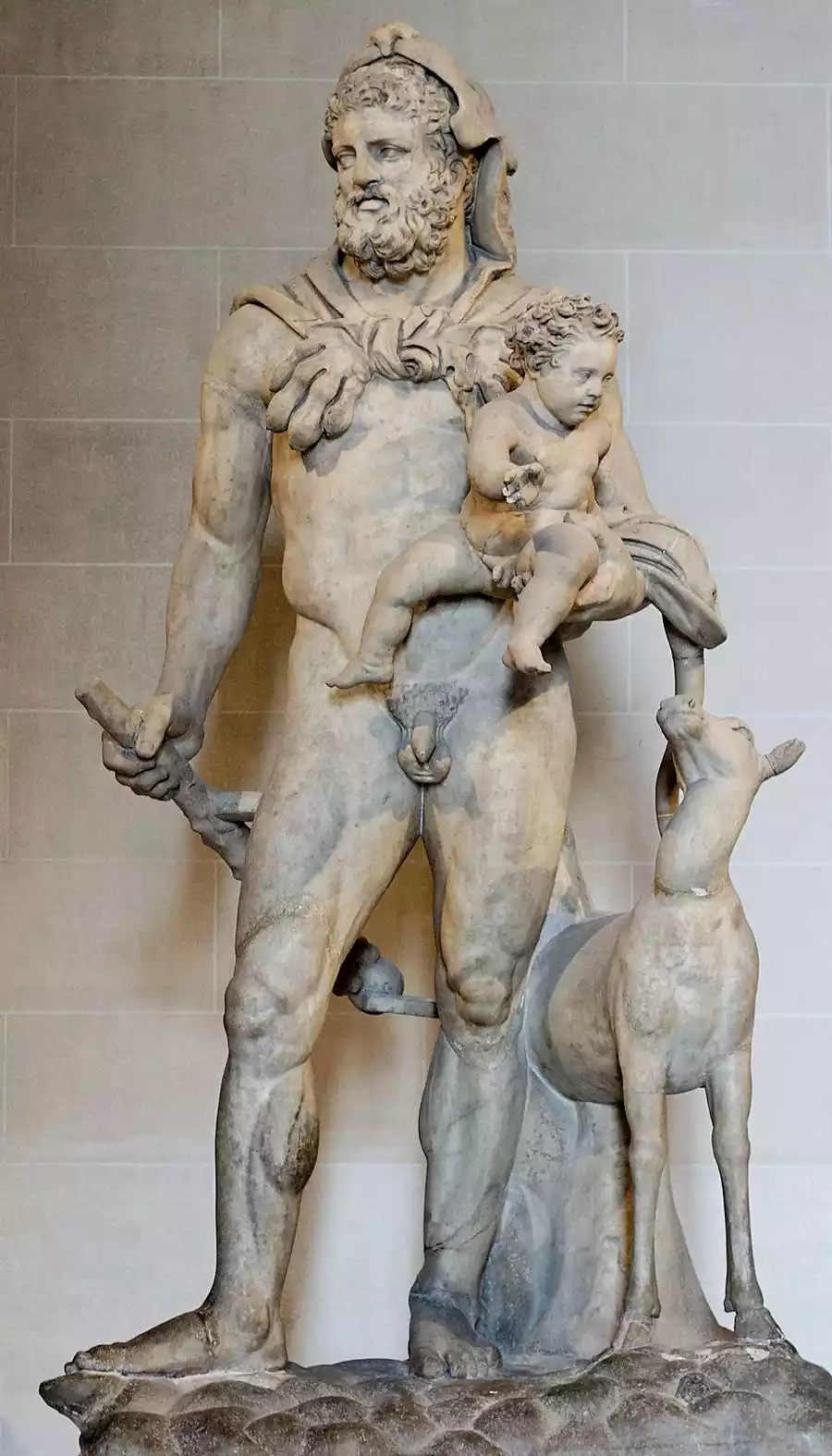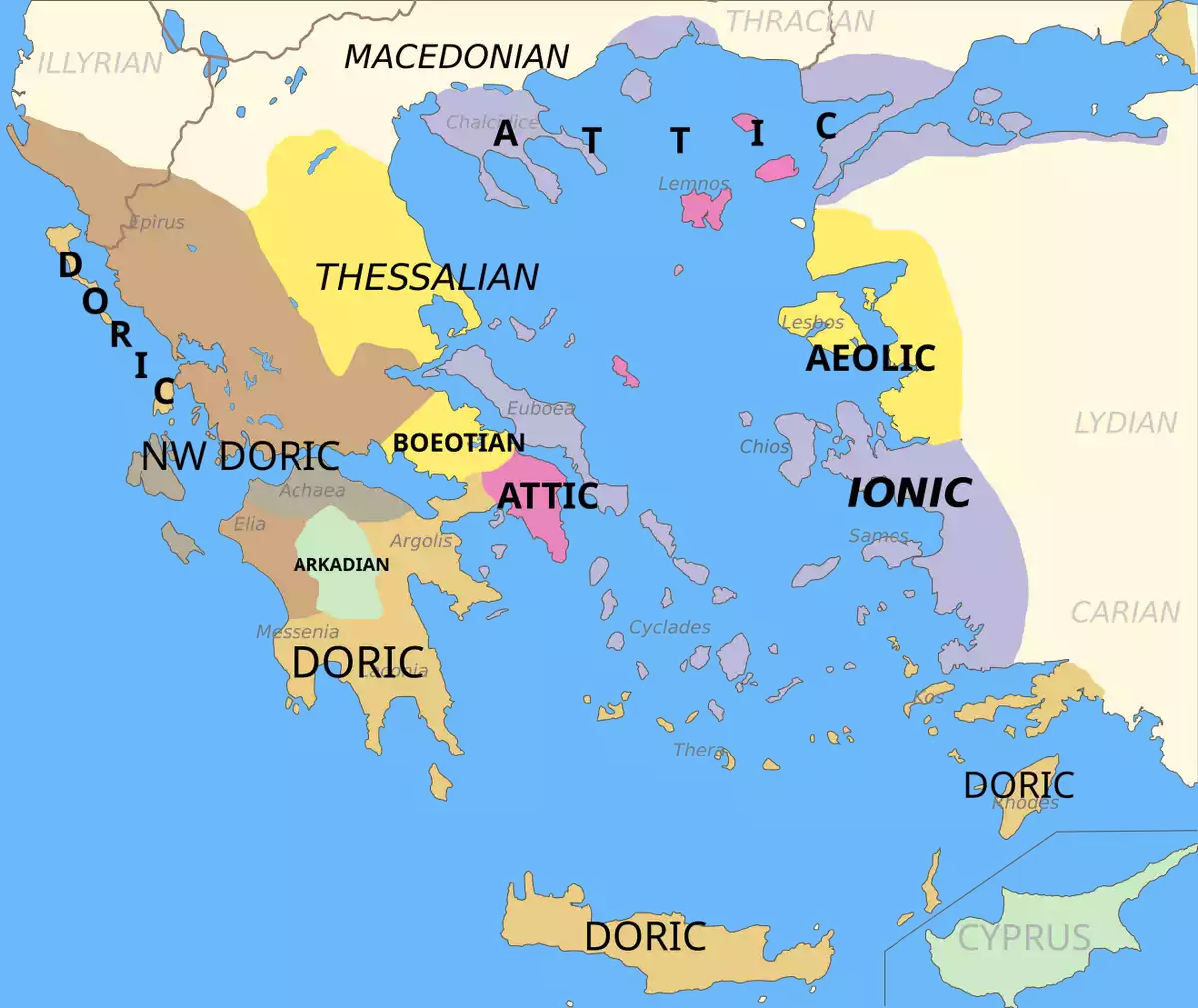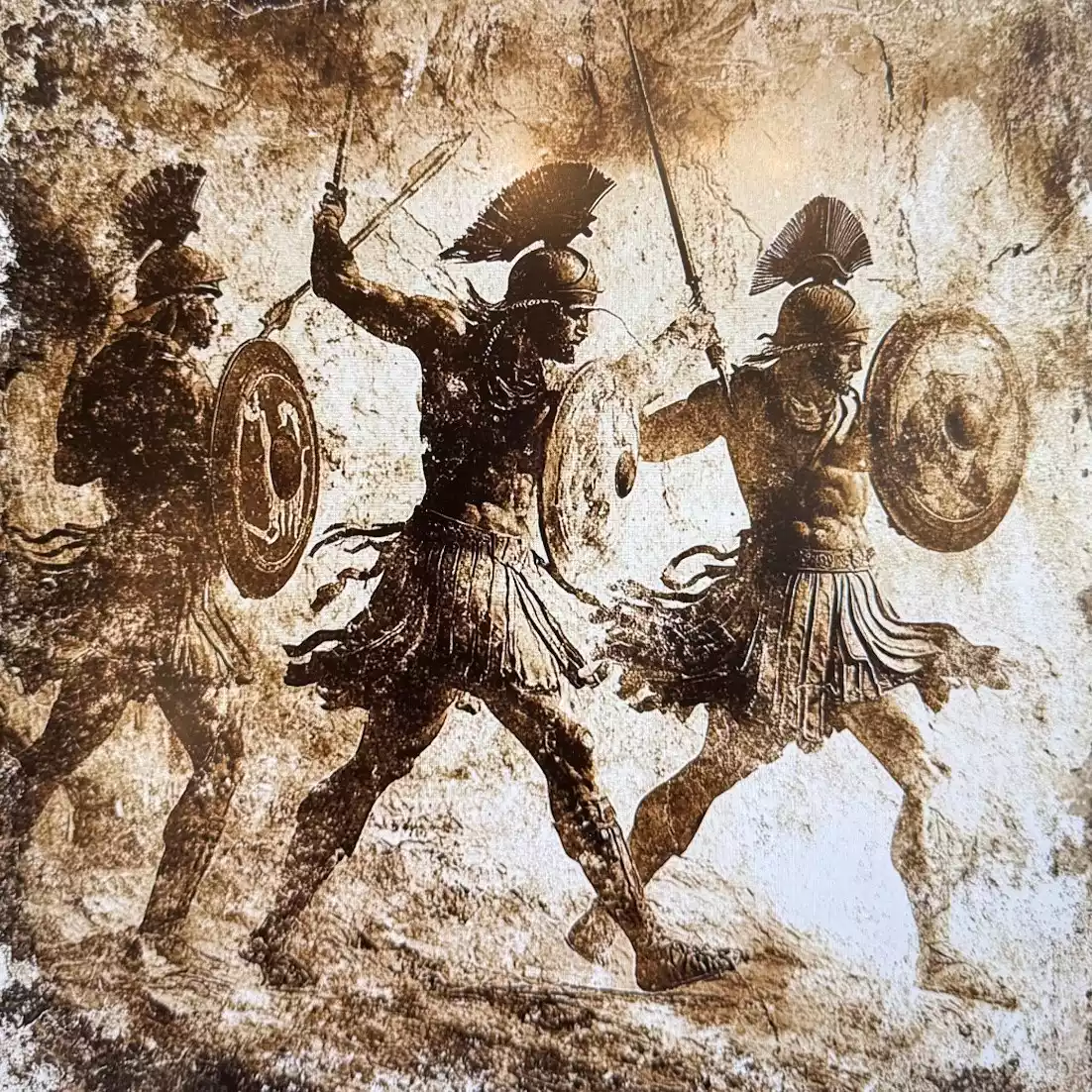Heracles and Telephus. Roman marble copy (1st-2nd century AD) of a Greek original (4th century BC). Louvre Museum (Paris, France).
In the rich canvas of Greek mythology, few stories resonate as strongly as that of the Heracleidae, the descendants of the legendary hero Heracles. It is not merely a genealogical record, but an epic narrative of displacement, wandering, and eventual return, a story that is inextricably linked to cataclysmic changes in the ancient Greek world. The Heracleidae, driven from their homeland, the Peloponnese, after the death of their glorious ancestor, embodied persistence and the claim to their heritage. Their journey, fraught with difficulties and battles, constitutes a central chapter of mythical history, illuminating population movements, political upheavals, and the formation of the kingdoms that dominated the classical era. Their story of return, often identified with the so-called “Dorian Invasion,” mythologically explains the dominance of the Dorian tribes in regions such as Sparta, Argos, and Messenia. The legends surrounding the Heracleidae, embellished with divine interventions, heroic deeds, and tragic losses, offer a captivating glimpse into the ancient Greeks’ perceptions of origin, justice, and destiny (Papathomas). Understanding their history is essential to grasp the transition from the Mycenaean era to the archaic and classical periods of Greek history.
The hero Heracles, from whom the Heracleidae descended, with his protector Athena. Interior of a kylix, work of Douris. State Archaeological Collections (Munich, Germany).
The Progeny of a Hero: Who Were the Heracleidae?
In the grand tapestry of Greek mythology, the Heracleidae stand as the numerous descendants of the quintessential hero, Heracles (or Hercules, as the Romans knew him). Born of the union between Zeus, king of the gods, and the mortal woman Alcmene, Heracles fathered a multitude of children with various partners throughout his tumultuous life. While many offspring dotted his lineage, the narrative of the “Return” primarily focuses on those descended through his marriage to Deianira, most notably their son Hyllus, and others who carved their own paths, like Tlepolemus, who led the Rhodians in the Trojan War. The collective term “Heracleidae” signifies this sprawling family tree, united by their shared ancestry from the greatest of Greek heroes. Their story is not merely a genealogy; it’s an epic saga of displacement, struggle, and eventual, hard-won homecoming, deeply intertwined with the shaping of ancient Greece. The very idea of heroic descendants claiming their birthright resonates through many cultural narratives (Collectif et al.).
Flight and Exile: The Wrath of Eurystheus
Following the death and subsequent apotheosis (deification) of Heracles, his children found themselves vulnerable. Their primary antagonist was Eurystheus, the king of Mycenae and Tiryns – the very man who had tasked Heracles with his legendary Twelve Labours. Driven by fear and paranoia that the hero’s powerful offspring would usurp his throne, Eurystheus initiated a relentless persecution. He demanded that various Greek cities expel the Heracleidae, threatening war upon any who offered them shelter.
Initially led by Heracles’ loyal nephew and companion-in-arms, Iolaus, and Heracles’ mother, Alcmene, the Heracleidae sought refuge with Ceyx, king of Trachis. However, Eurystheus’ pressure proved too great, forcing them to flee once more. Their desperate search for sanctuary led them to Athens, a city renowned for its adherence to justice and its willingness to protect the supplicant.
Athenian Sanctuary and the Fall of a Tyrant
In Athens, under the protection of King Theseus (or his sons, depending on the version of the myth), the Heracleidae found temporary respite. This act of compassion, however, brought the conflict to Athens’ doorstep. Eurystheus, enraged by the Athenians’ defiance, marshalled his forces and invaded Attica, demanding the surrender of Heracles’ children.
The ensuing battle, often located near Marathon, saw the Athenians, bolstered by the fighting prowess of the Heracleidae (particularly Hyllus, now a grown man), decisively defeat the Mycenaean king. Eurystheus himself met his end – some accounts say he was slain in battle by Hyllus, others that he was captured and later executed (potentially at the behest of the vengeful Alcmene). Euripides’ play, Heracleidae, vividly dramatizes this Athenian episode, highlighting the themes of asylum, justice, and divine favour. With their tormentor finally vanquished, the path seemed clear for the Heracleidae to reclaim their ancestral lands in the Peloponnese.
The Long Road Home: Failed Attempts and Oracular Guidance
The journey back to the Peloponnese, the heartland ruled by their ancestors, proved fraught with difficulty and delay. Their initial attempt, led by Hyllus, ended in disaster. Misinterpreting an oracle from Delphi, which advised them to return “after the third fruit” and via a “narrow passage by sea,” Hyllus believed this meant after three years and through the Isthmus of Corinth. He challenged Echemus, the king of Tegea, to single combat at the Isthmus, was defeated, and killed. Bound by an oath made after this failure, the Heracleidae agreed not to attempt another return for a significant period – sources vary between fifty and one hundred years.
Generations passed. Finally, the great-grandsons of Hyllus – Temenus, Cresphontes, and Aristodemus – prepared for a renewed effort. They sought clarification from Delphi and received the correct interpretation: “third fruit” referred to the third generation, and the “narrow passage by sea” meant the Strait of Rhium, the narrow entrance to the Corinthian Gulf near modern Patras. Guided by another oracle instructing them to find a “three-eyed man” as their leader (whom they found in the figure of Oxylus, an Aetolian exile who had lost an eye and rode a one-eyed horse, thus totalling three eyes between man and steed), they assembled a fleet at Naupactus. This time, crossing the strait successfully, they finally set foot in the Peloponnese.
Conquest and Division: The “Dorian Invasion”
The arrival of the Heracleidae, alongside their Dorian allies, marked a pivotal moment often mythologically equated with the historical phenomenon known as the “Dorian Invasion.” This narrative explains the displacement of the existing Achaean and Ionian populations and the rise of Dorian dominance in the Peloponnese. Their primary adversary was Tisamenus, son of Orestes and grandson of Agamemnon, who ruled over Argos, Mycenae, and Sparta.
In the ensuing conflict, the Heraclid-Dorian forces were victorious. Tisamenus was killed, and his Achaean followers were driven out, eventually settling in the northern Peloponnese (the region subsequently known as Achaea). With the major centres secured, the three leading Heraclid brothers (or, in the case of Aristodemus, who was struck by lightning before the final victory, his twin sons Eurysthenes and Procles) decided to divide the conquered lands by lot.
Establishing the Kingdoms
- Argos: Temenus received Argos and the surrounding Argolid plain. His reign, however, was marred by internal strife when his sons, feeling slighted in favour of their brother-in-law Deiphontes, assassinated him. Despite this initial turmoil, his lineage established the Heraclid dynasty of Argos.
- Sparta (Lacedaemon): The twins Eurysthenes and Procles were allotted Laconia. This division established Sparta’s unique dual monarchy, with two simultaneous kings descending from these two Heraclid lines (the Agiads from Eurysthenes and the Eurypontids from Procles) throughout Spartan history. Their divine ancestry through Heracles conferred immense prestige.
- Messenia: Cresphontes claimed the fertile land of Messenia. He attempted a more conciliatory rule, aiming to integrate the Dorian newcomers with the existing populace. This policy angered the Dorian aristocracy, who eventually murdered him and most of his sons. Only the youngest, Aepytus, survived, later returning to avenge his father and reclaim the throne.
Their ally, Oxylus the Aetolian, was rewarded with Elis for his guidance. This mythical division provided a foundational charter for the political geography of the Dorian Peloponnese. The story itself became a popular subject, with various artistic representations appearing on pottery and other media, reflecting its cultural significance (Gogos).
The Heraclid Legacy Beyond the Peloponnese
The influence of the Heracleidae wasn’t confined to the Peloponnese. Tlepolemus, another son of Heracles, had established himself as ruler of Rhodes much earlier. Furthermore, claims of Heraclid descent were used to legitimize power far beyond southern Greece. Most famously, the Argead dynasty of Macedon, culminating in Alexander the Great, traced its lineage back to Heracles through Temenus of Argos. Similarly, the powerful Bacchiadae clan, who ruled Corinth, also asserted kinship with the Heracleidae. These widespread claims underscore the immense cultural capital attached to Heracles and the importance of heroic ancestry in validating kingship and aristocracy across the Hellenic world. The enduring power of these legends speaks volumes about how ancient societies constructed their identities and histories (Papathomas).
Historical Interpretations and Scholarly Debate
While central to ancient Greek tradition, the narrative of the Heracleidae’s return and the associated “Dorian Invasion” has been subject to intense scrutiny by modern historians and archaeologists. The traditional view, based largely on ancient literary sources, posits a relatively swift, large-scale migration or invasion by Dorian peoples, led by the Heracleidae, which overthrew the Mycenaean palace-states around the 12th century BC.
However, contemporary scholarship often challenges this straightforward interpretation. Figures like Jonathan M. Hall have questioned the coherence of a distinct “Dorian” ethnic identity in this early period and the notion of a single, cataclysmic Dorian invasion, suggesting instead a more complex process of gradual infiltration, internal shifts, and elite competition (Hall). Earlier scholars like Vincent Desborough, while acknowledging complexities, placed more weight on archaeological evidence suggesting disruption and the arrival of new cultural elements, potentially aligning more closely with the traditional migration narrative.
The archaeological evidence remains ambiguous. While destruction layers exist at some Mycenaean sites, continuity is evident at others. Changes in burial customs (like the appearance of cist graves mentioned by Desborough), pottery styles (Submycenaean and Protogeometric), and the adoption of iron are debated as indicators of either internal evolution or external influence. Ultimately, the question remains whether the myth of the Heracleidae reflects a distorted historical memory of population movements and societal upheaval at the end of the Bronze Age, or if it primarily served as a later ideological construct to legitimize the power structures of the Dorian states in the historical period.
Map of the spread of ancient Greek dialects (based on Woodard/Risch). The Dorian areas linked to the Heracleidae are shown in orange.
Epilogue
The story of the Heracleidae, the legendary descendants of Heracles, transcends the boundaries of a simple mythological narrative. It served as a fundamental origin myth for some of the most powerful city-states of ancient Greece, primarily Sparta, Argos, and Messenia, but also for dynasties such as the Argeads of Macedonia. Their epic journey – from the injustice of exile, through the hardships of wandering, and finally to the triumphant, albeit bloody, return to their ancestral land of the Peloponnese – embodied ideals such as persistence, the quest for justice, and the significance of heroic heritage. Inextricably linked to the controversial “Dorian Invasion,” the story of the Heracleidae sought to explain the great upheavals that marked the transition from the Bronze Age to the Iron Age in the Greek world, shaping the political and cultural landscape of classical Greece.
The shadow of Heracles looms large over his descendants. The story of the Heracleidae is a narrative of heritage, claim, and destiny.
Frequently Asked Questions
H3: Who exactly are considered Heracleidae in Greek mythology?
Answer: In Greek mythology, Heracleidae refers to all the descendants of the demigod Heracles. Although Heracles had many children, the narrative of the “Return” (or “Invasion”) primarily focuses on his sons and grandsons who, after his death and their exile, claimed and ultimately conquered the kingdoms of the Peloponnese, such as Hyllus, Temenus, Cresphontes, and the twin founders of Sparta.
H3: Is there a historical basis for the myth of the return of the Heracleidae?
Answer: The historicity of the return of the Heracleidae, as described in Greek mythology, is a subject of discussion. Many historians link the myth to the movements of the Dorians at the end of the Mycenaean era. However, it is disputed whether it is an accurate record of events or a later myth aimed at legitimizing the power of the Dorian descendants of Heracles.
H3: What is the relationship between the story of Heracles’ descendants and Sparta?
Answer: The relationship is fundamental to Greek mythology and the history of Sparta. The two royal houses of Sparta, the Agiad and the Eurypontid, claimed direct descent from the twin Heracleidae Eurysthenes and Procles, sons of Aristodemus. This Heracleid descent conferred sanctity and prestige to the unique dual kingship of the city.
H3: Why did Eurystheus pursue the Heracleidae?
Answer: According to Greek mythology, Eurystheus, king of Mycenae, was the one who assigned the labors to Heracles. After the hero’s death, Eurystheus feared that the numerous and powerful Heracleidae, as the legitimate heirs of their ancestor, would claim the throne of Argos and Mycenae. This fear led him to exile and pursue the descendants of Heracles.
H3: How was the Peloponnese divided among the Heracleidae?
Answer: After the successful invasion and the defeat of Tisamenus, the three main leaders of the Heracleidae divided the conquered areas of the Peloponnese by lot, according to Greek mythology. Temenus received Argos, the sons of Aristodemus (Eurysthenes and Procles) received Laconia (Sparta), and Cresphontes received Messenia.
Bibliography
- Collectif, Corinne Bonnet, and Colette Jourdain-Annequin. The Bestiary of Heracles: IIIrd Heraclean Meeting. Presses universitaires de Liège, 2013.
- Gogos, Savvas. “The” ancient theater of Dionysus: architectural form and…. Ministry of Culture, Archaeological Resources and Expropriations Fund, 2005.
- Hall, Jonathan M. Ethnic Identity in Greek Antiquity. Cambridge University Press, 2000.
- Papathomas, Amphilochios. “The” first book of Herodotus’ Histories: memories, legends…. Stamoulis Publications, 2015.





